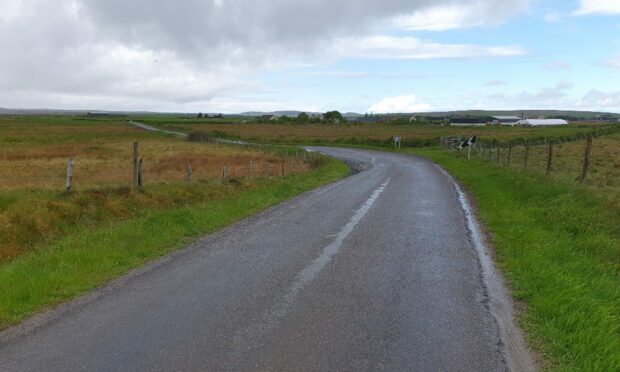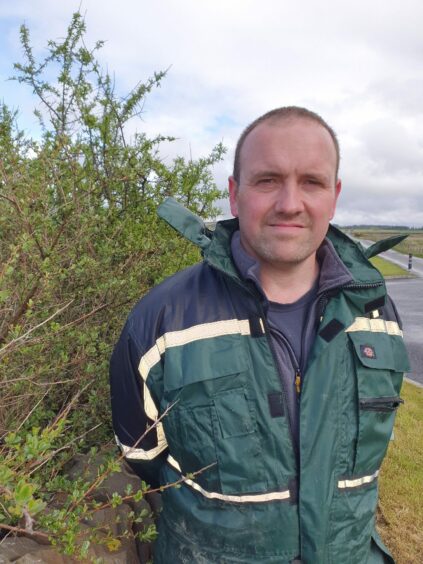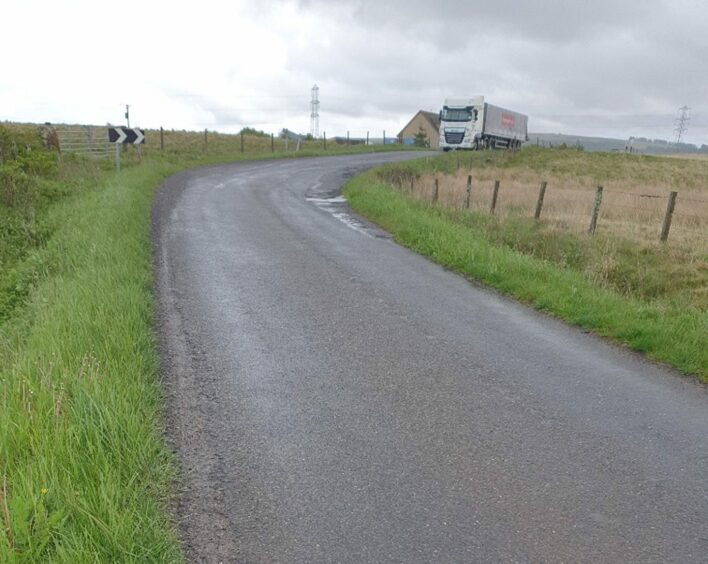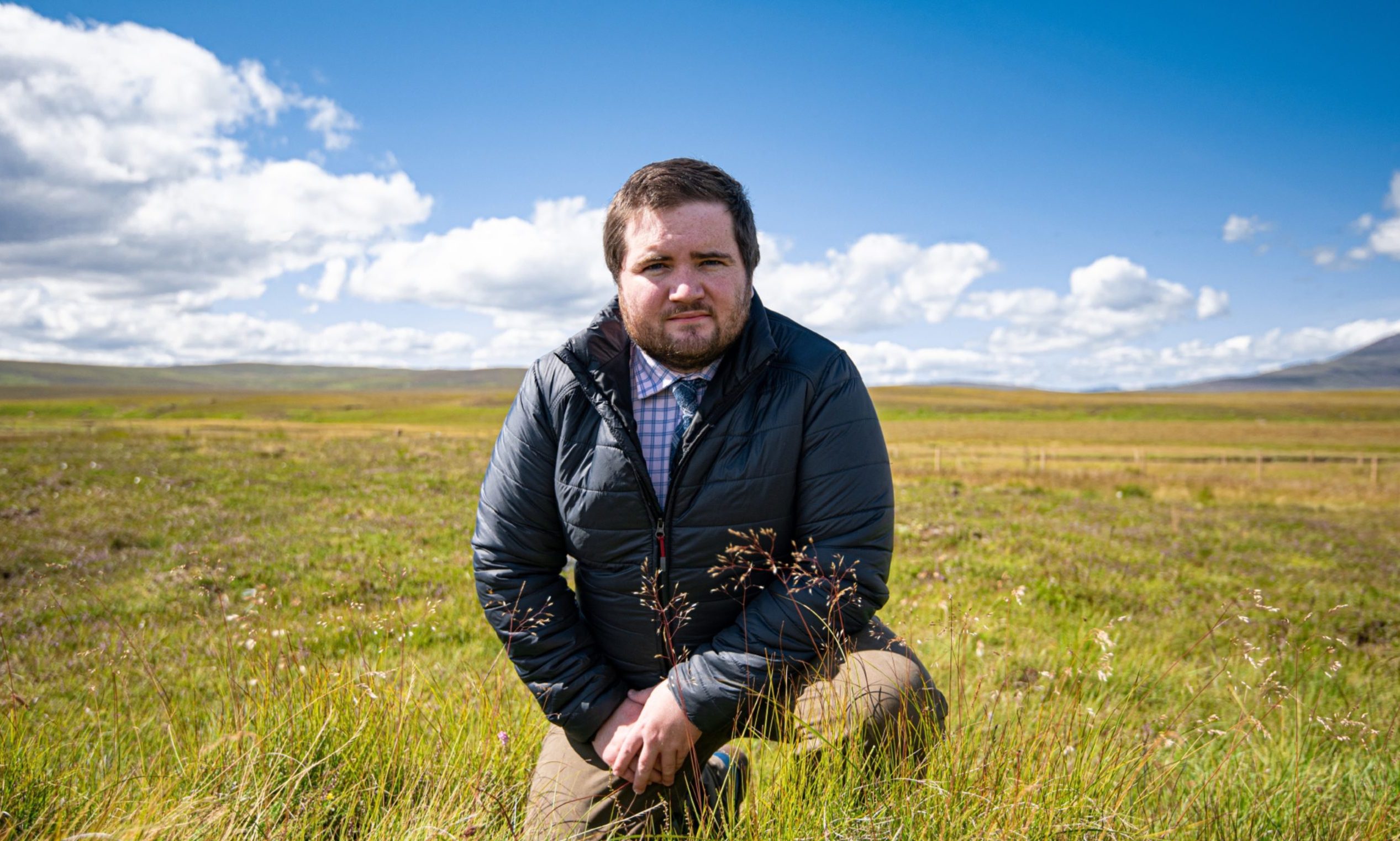A Caithness dad is battling Highland Council after it ruled that a single-track, unlit road is a safe route to the school bus stop.
Twelve-year-old Isla Sutherland walks the route at Achalone, Halkirk, most days to get to the bus stop for Thurso High School.
However, her dad Innes Sutherland is concerned about heavy traffic, flooding and poor visibility on the remote country road.
Mr Sutherland wrote to Highland Council and waited several months to get a response – only to be told the road is safe.
He has now taken the matter up with local councillor Struan Mackie.
Concerns over lorries and blind bends
The primary school bus picks up Isla’s younger siblings from their home, after Mr Sutherland negotiated an agreement with the local bus company.
However, the high school bus service has a different operator. Mr Sutherland wants the high school minibus to pick up Isla too. He’s concerned about potential for an accident, especially in winter.
“The road is totally unacceptable for anybody to walk on, never mind a child,” he says. “There’s no lighting. It’s a single track road. My biggest concern is the traffic from nearby Spittal and Banniskirk quarries, and there’s a lot of HGVs, arctic lorries, fuel tankers – and tractors as well.
“In summer time, it’s not so bad, but on winter mornings it’s not acceptable. The road falls off round a corner just before our house so you could be on a pedestrian before you know it.”
‘Suitable walking route’ says council
Highland Council paid a site visit to the Caithness school bus route on 13 January. The risk assessment – seen by the P&J – rates the route amber and green, against a range of safety measures.
Here’s an overview of the scores:
Amber
No adequate footpath
No lights
Traffic speed – national speed limit, but most traffic was travelling slower than 60 mph
Green
Single track – adequate room for cars and pedestrians to pass, and grass verge to step on
Traffic volume – only three vehicles observed on site visit
HGVs – none seen on site visit, although a tractor picked up a pupil at the bus stop
The report concludes: “Road is suitable as a walking route, with a low level of traffic and a flat even walk.”
It adds that Isla was seen walking the route wearing dark clothes and watching her phone, and advises hi-vis clothing and a torch on dark days.
‘I can only look out for my own kid’
Mr Sutherland accepts this advice, and has given hi-vis clothes to his daughter. However, he still feels Highland Council has a responsibility to get its pupils to school safely.
“I work offshore and my wife works at Dounreay – plus we have two younger kids at home – so we can’t regularly take Isla to the bus stop,” he says.
Even if he could, he feels an unsafe road is just as dangerous to adults as it is to children.
Yet it begs the question: is it reasonable to expect the council to pick pupils up from their own homes? It’s a vast and rural area.
Mr Sutherland says he understands the logistical challenges, including the budget. Highland Council advised him that some children have to walk two miles to the school bus.
But this, he says, is missing the point.
“If there was a safe route we would tell her just to get on with it,” he says. “Children nowadays get mollycoddled so getting out in the rain isn’t the issue. It’s the fact that the road is unsafe.”
Halkirk is home to a large number of wind farms, and Mr Sutherland is open to exploring whether developer contributions could fund a safe, gravel path for the whole community to use.
If this could be put in place, Isla could walk to the bus stop.
Yet discussions with Highland Council have been painfully slow.
Mr Sutherland sent a succession of emails in recent months, requesting the risk assessment report and updates. He is frustrated with the lack of progress.
“They’re just not willing to respond,” he says. “I can’t get hold of them.”
Council says it doesn’t do ‘door to door’
Councillor Struan Mackie has taken up the family’s case. He says it’s one of many across the far north.
“Ensuring that children are able to travel to and from school is fundamentally a safety matter and I am frustrated that the Council appears very inflexible,” says Mr Mackie.
“There does not appear to be a clear process for appealing decisions, and I feel elected members must be able to influence these decisions on behalf of constituents.
“I understand that the council is hard-pressed for cash and that savings must be made but flexibility and pragmatism to deliver the safest possible routes to school must prevail.”
A spokesperson for Highland Council said it can’t comment on individual pupils, but highlighted that school transport policy does not include door-to-door provision. Routes are designed to avoid excessive journey times for the furthest pupils, and to be cost-effective. Pupils may be required to travel up to the statutory walking distances (two miles under age eight; three miles for eight and over).
Highland Council added: “It is a parental responsibility to ensure that pupils get to the pick-up point (or to school if not eligible for transport). If the route has been assessed a suitable for walking (within the distance limits), the Council no duty to provide transport.”
However, Mr Sutherland intends to keep pushing for a solution.
“I can’t look out for every kid in the Highlands; I can only look out for my kid,” he says.
“There could be a catastrophe here, and the simple fact is, I’m a parent and I have to live with myself if anything happens. So that means taking things to the limit of what I think is right, and that’s what I’m doing.”
More from the Schools & Family team
Elgin family reveal ‘soul destroying’ battle to secure place in special needs school
Real Life Parenting Dilemmas: Is there a perfect formula for weaning?




Conversation